BMW 7 SERIES LONG 2013 F02 Owner's Manual
Manufacturer: BMW, Model Year: 2013, Model line: 7 SERIES LONG, Model: BMW 7 SERIES LONG 2013 F02Pages: 255, PDF Size: 5.22 MB
Page 201 of 255
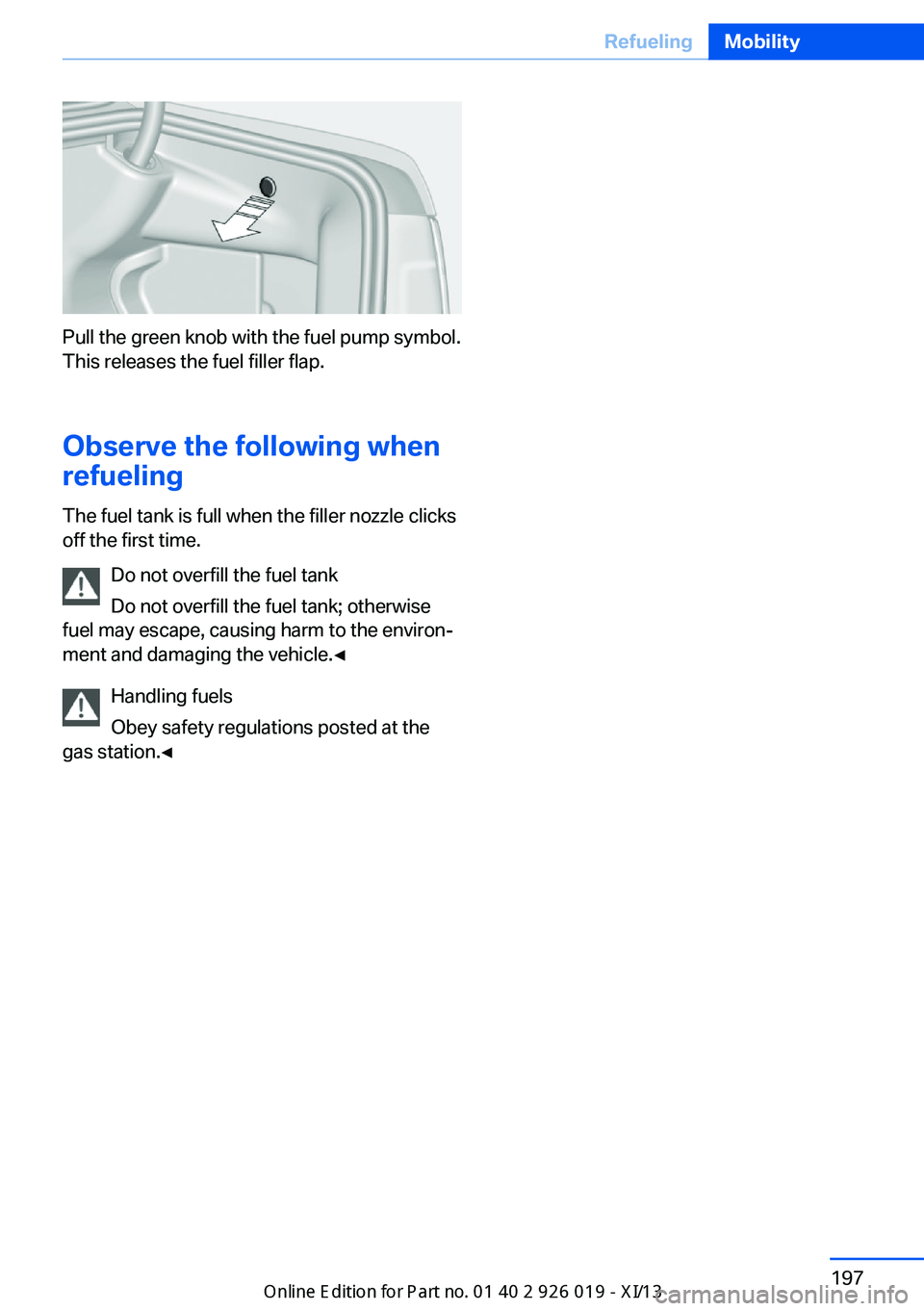
Pull the green knob with the fuel pump symbol.
This releases the fuel filler flap.
Observe the following when
refueling
The fuel tank is full when the filler nozzle clicks
off the first time.
Do not overfill the fuel tank
Do not overfill the fuel tank; otherwise
fuel may escape, causing harm to the environ‐
ment and damaging the vehicle.◀
Handling fuels
Obey safety regulations posted at the
gas station.◀
Seite 197RefuelingMobility197
Online Edition for Part no. 01 40 2 909 749 - VI/13
Page 202 of 255
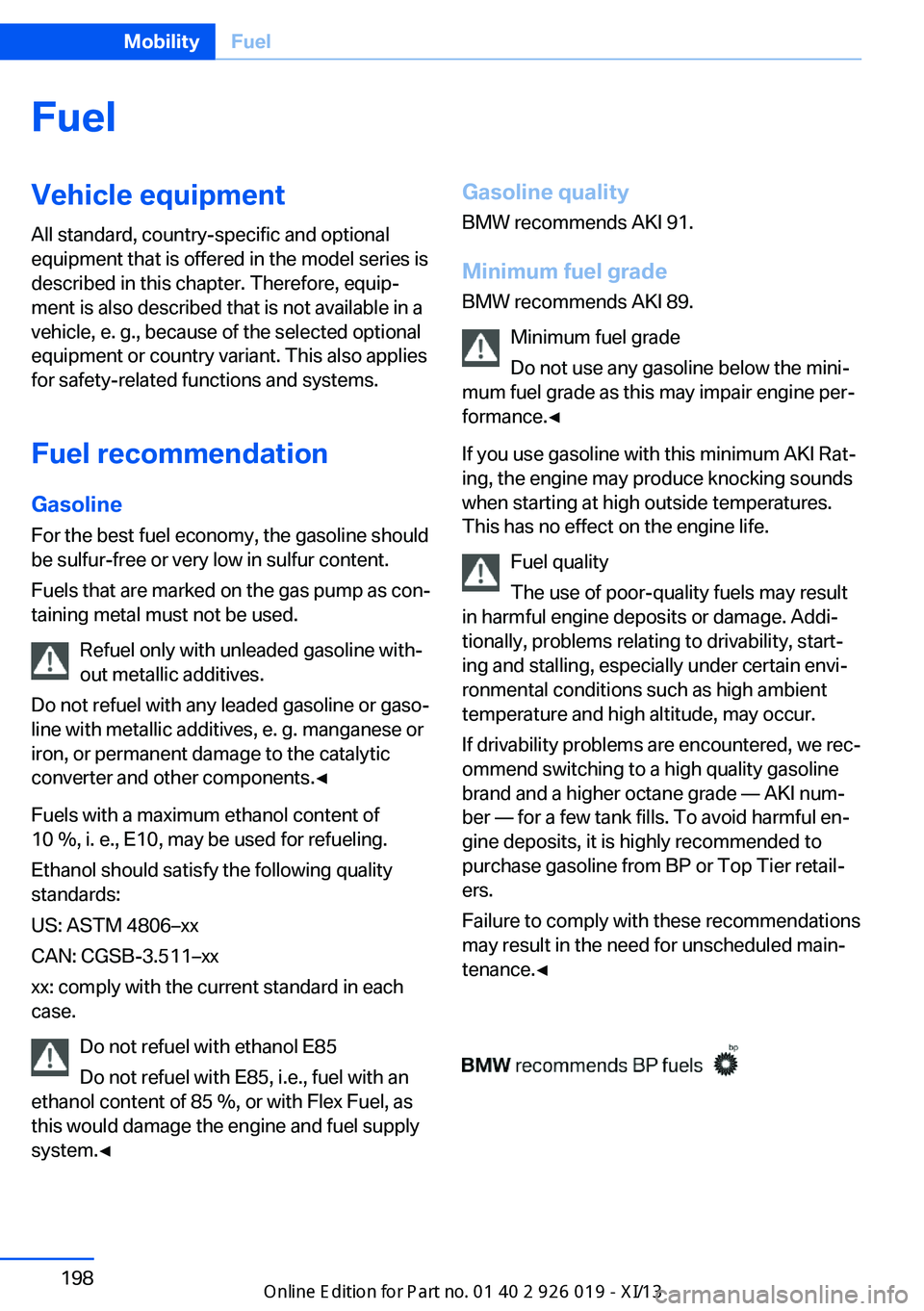
FuelVehicle equipmentAll standard, country-specific and optional
equipment that is offered in the model series is
described in this chapter. Therefore, equip‐
ment is also described that is not available in a
vehicle, e. g., because of the selected optional
equipment or country variant. This also applies
for safety-related functions and systems.
Fuel recommendation Gasoline For the best fuel economy, the gasoline should
be sulfur-free or very low in sulfur content.
Fuels that are marked on the gas pump as con‐
taining metal must not be used.
Refuel only with unleaded gasoline with‐
out metallic additives.
Do not refuel with any leaded gasoline or gaso‐
line with metallic additives, e. g. manganese or
iron, or permanent damage to the catalytic
converter and other components.◀
Fuels with a maximum ethanol content of
10 %, i. e., E10, may be used for refueling.
Ethanol should satisfy the following quality
standards:
US: ASTM 4806–xx
CAN: CGSB-3.511–xx
xx: comply with the current standard in each
case.
Do not refuel with ethanol E85
Do not refuel with E85, i.e., fuel with an
ethanol content of 85 %, or with Flex Fuel, as
this would damage the engine and fuel supply
system.◀Gasoline quality
BMW recommends AKI 91.
Minimum fuel grade
BMW recommends AKI 89.
Minimum fuel grade
Do not use any gasoline below the mini‐
mum fuel grade as this may impair engine per‐
formance.◀
If you use gasoline with this minimum AKI Rat‐
ing, the engine may produce knocking sounds
when starting at high outside temperatures.
This has no effect on the engine life.
Fuel quality
The use of poor-quality fuels may result
in harmful engine deposits or damage. Addi‐
tionally, problems relating to drivability, start‐ ing and stalling, especially under certain envi‐
ronmental conditions such as high ambient
temperature and high altitude, may occur.
If drivability problems are encountered, we rec‐
ommend switching to a high quality gasoline
brand and a higher octane grade — AKI num‐
ber — for a few tank fills. To avoid harmful en‐
gine deposits, it is highly recommended to
purchase gasoline from BP or Top Tier retail‐
ers.
Failure to comply with these recommendations
may result in the need for unscheduled main‐
tenance.◀Seite 198MobilityFuel198
Online Edition for Part no. 01 40 2 909 749 - VI/13
Page 203 of 255
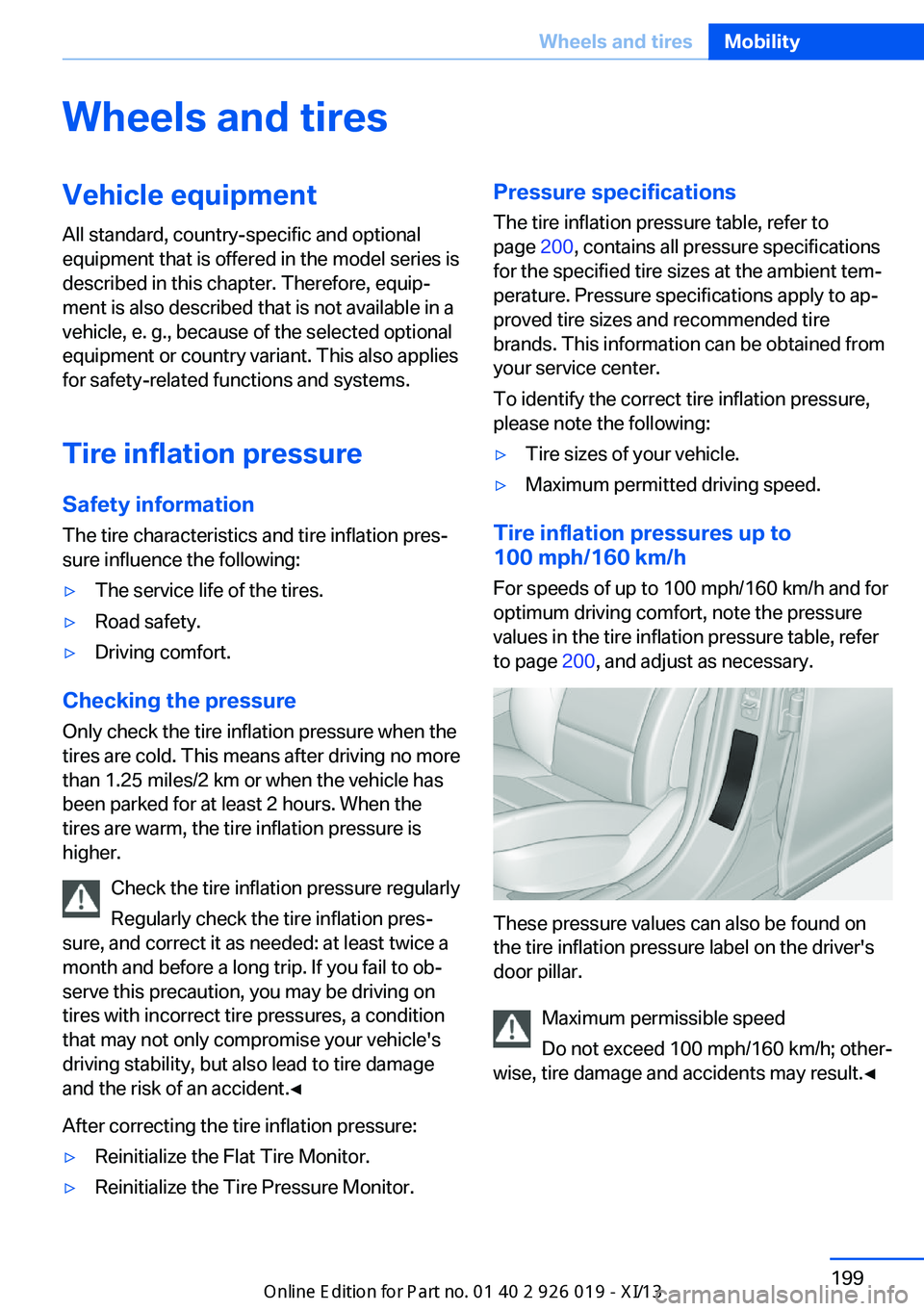
Wheels and tiresVehicle equipment
All standard, country-specific and optional
equipment that is offered in the model series is
described in this chapter. Therefore, equip‐
ment is also described that is not available in a
vehicle, e. g., because of the selected optional
equipment or country variant. This also applies
for safety-related functions and systems.
Tire inflation pressure Safety information
The tire characteristics and tire inflation pres‐
sure influence the following:▷The service life of the tires.▷Road safety.▷Driving comfort.
Checking the pressure
Only check the tire inflation pressure when the
tires are cold. This means after driving no more
than 1.25 miles/2 km or when the vehicle has
been parked for at least 2 hours. When the
tires are warm, the tire inflation pressure is
higher.
Check the tire inflation pressure regularly
Regularly check the tire inflation pres‐
sure, and correct it as needed: at least twice a
month and before a long trip. If you fail to ob‐
serve this precaution, you may be driving on
tires with incorrect tire pressures, a condition
that may not only compromise your vehicle's
driving stability, but also lead to tire damage
and the risk of an accident.◀
After correcting the tire inflation pressure:
▷Reinitialize the Flat Tire Monitor.▷Reinitialize the Tire Pressure Monitor.Pressure specifications The tire inflation pressure table, refer to
page 200, contains all pressure specifications
for the specified tire sizes at the ambient tem‐
perature. Pressure specifications apply to ap‐
proved tire sizes and recommended tire
brands. This information can be obtained from
your service center.
To identify the correct tire inflation pressure,
please note the following:▷Tire sizes of your vehicle.▷Maximum permitted driving speed.
Tire inflation pressures up to
100 mph/160 km/h
For speeds of up to 100 mph/160 km/h and for
optimum driving comfort, note the pressure
values in the tire inflation pressure table, refer
to page 200, and adjust as necessary.
These pressure values can also be found on
the tire inflation pressure label on the driver's
door pillar.
Maximum permissible speed
Do not exceed 100 mph/160 km/h; other‐
wise, tire damage and accidents may result.◀
Seite 199Wheels and tiresMobility199
Online Edition for Part no. 01 40 2 909 749 - VI/13
Page 204 of 255
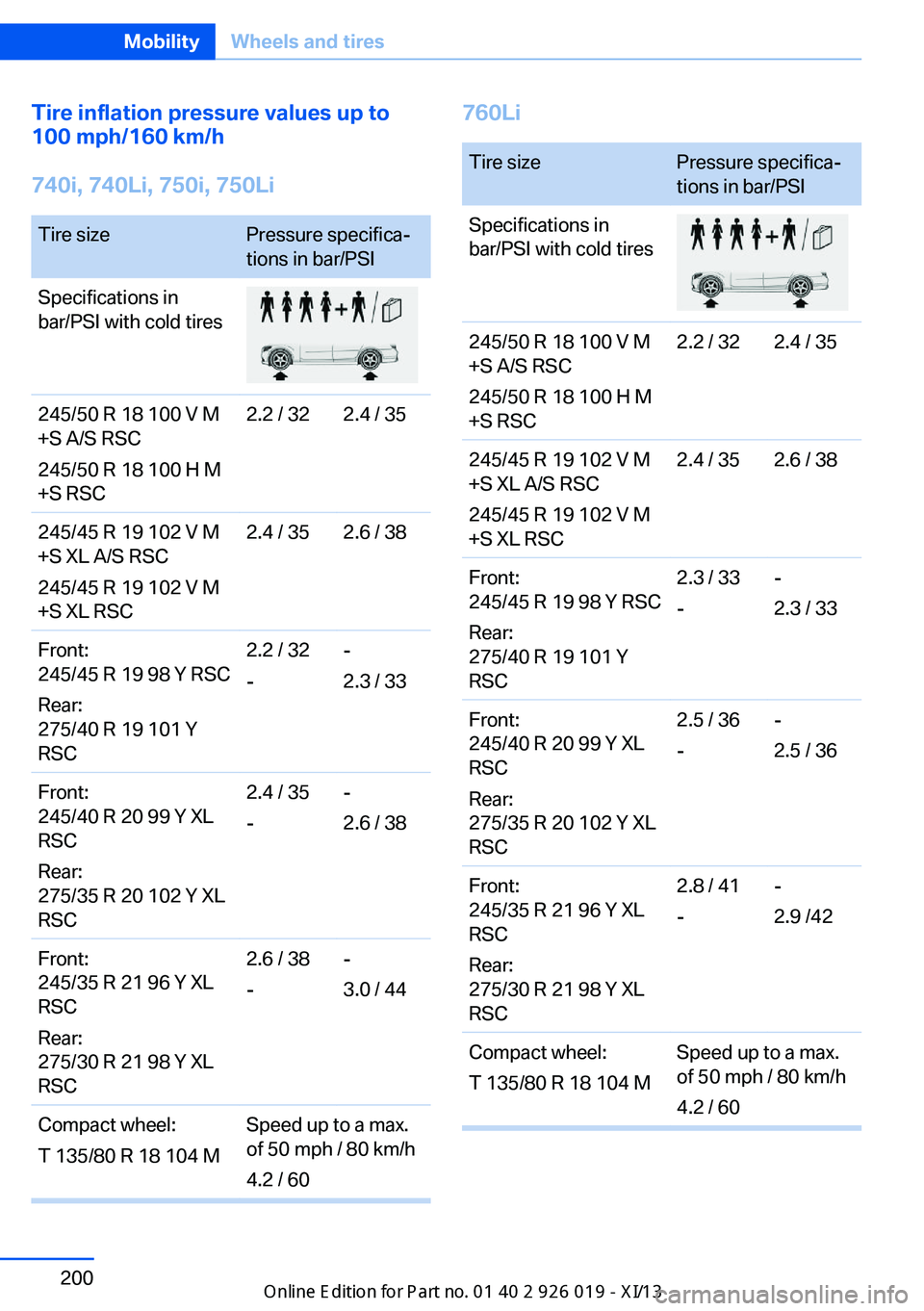
Tire inflation pressure values up to
100 mph/160 km/h
740i, 740Li, 750i, 750LiTire sizePressure specifica‐
tions in bar/PSISpecifications in
bar/PSI with cold tires245/50 R 18 100 V M
+S A/S RSC
245/50 R 18 100 H M
+S RSC2.2 / 322.4 / 35245/45 R 19 102 V M
+S XL A/S RSC
245/45 R 19 102 V M
+S XL RSC2.4 / 352.6 / 38Front:
245/45 R 19 98 Y RSC
Rear:
275/40 R 19 101 Y
RSC2.2 / 32
--
2.3 / 33Front:
245/40 R 20 99 Y XL
RSC
Rear:
275/35 R 20 102 Y XL
RSC2.4 / 35
--
2.6 / 38Front:
245/35 R 21 96 Y XL
RSC
Rear:
275/30 R 21 98 Y XL
RSC2.6 / 38
--
3.0 / 44Compact wheel:
T 135/80 R 18 104 MSpeed up to a max.
of 50 mph / 80 km/h
4.2 / 60760LiTire sizePressure specifica‐
tions in bar/PSISpecifications in
bar/PSI with cold tires245/50 R 18 100 V M
+S A/S RSC
245/50 R 18 100 H M
+S RSC2.2 / 322.4 / 35245/45 R 19 102 V M
+S XL A/S RSC
245/45 R 19 102 V M
+S XL RSC2.4 / 352.6 / 38Front:
245/45 R 19 98 Y RSC
Rear:
275/40 R 19 101 Y
RSC2.3 / 33
--
2.3 / 33Front:
245/40 R 20 99 Y XL
RSC
Rear:
275/35 R 20 102 Y XL
RSC2.5 / 36
--
2.5 / 36Front:
245/35 R 21 96 Y XL
RSC
Rear:
275/30 R 21 98 Y XL
RSC2.8 / 41
--
2.9 /42Compact wheel:
T 135/80 R 18 104 MSpeed up to a max.
of 50 mph / 80 km/h
4.2 / 60Seite 200MobilityWheels and tires200
Online Edition for Part no. 01 40 2 909 749 - VI/13
Page 205 of 255
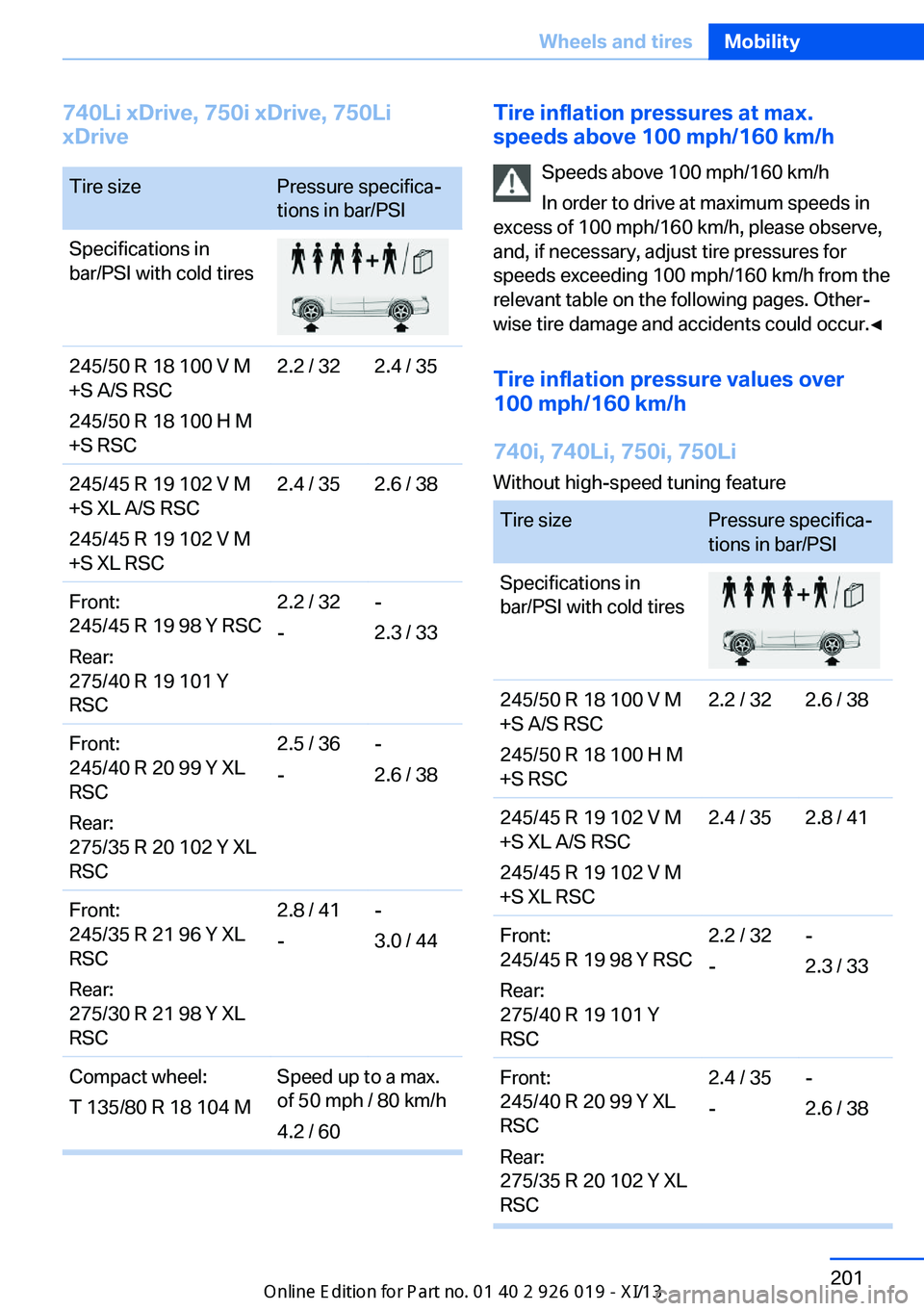
740Li xDrive, 750i xDrive, 750Li
xDriveTire sizePressure specifica‐
tions in bar/PSISpecifications in
bar/PSI with cold tires245/50 R 18 100 V M
+S A/S RSC
245/50 R 18 100 H M
+S RSC2.2 / 322.4 / 35245/45 R 19 102 V M
+S XL A/S RSC
245/45 R 19 102 V M
+S XL RSC2.4 / 352.6 / 38Front:
245/45 R 19 98 Y RSC
Rear:
275/40 R 19 101 Y
RSC2.2 / 32
--
2.3 / 33Front:
245/40 R 20 99 Y XL
RSC
Rear:
275/35 R 20 102 Y XL
RSC2.5 / 36
--
2.6 / 38Front:
245/35 R 21 96 Y XL
RSC
Rear:
275/30 R 21 98 Y XL
RSC2.8 / 41
--
3.0 / 44Compact wheel:
T 135/80 R 18 104 MSpeed up to a max.
of 50 mph / 80 km/h
4.2 / 60Tire inflation pressures at max.
speeds above 100 mph/160 km/h
Speeds above 100 mph/160 km/h
In order to drive at maximum speeds in
excess of 100 mph/160 km/h, please observe,
and, if necessary, adjust tire pressures for
speeds exceeding 100 mph/160 km/h from the
relevant table on the following pages. Other‐
wise tire damage and accidents could occur.◀
Tire inflation pressure values over
100 mph/160 km/h
740i, 740Li, 750i, 750Li Without high-speed tuning featureTire sizePressure specifica‐
tions in bar/PSISpecifications in
bar/PSI with cold tires245/50 R 18 100 V M
+S A/S RSC
245/50 R 18 100 H M
+S RSC2.2 / 322.6 / 38245/45 R 19 102 V M
+S XL A/S RSC
245/45 R 19 102 V M
+S XL RSC2.4 / 352.8 / 41Front:
245/45 R 19 98 Y RSC
Rear:
275/40 R 19 101 Y
RSC2.2 / 32
--
2.3 / 33Front:
245/40 R 20 99 Y XL
RSC
Rear:
275/35 R 20 102 Y XL
RSC2.4 / 35
--
2.6 / 38Seite 201Wheels and tiresMobility201
Online Edition for Part no. 01 40 2 909 749 - VI/13
Page 206 of 255
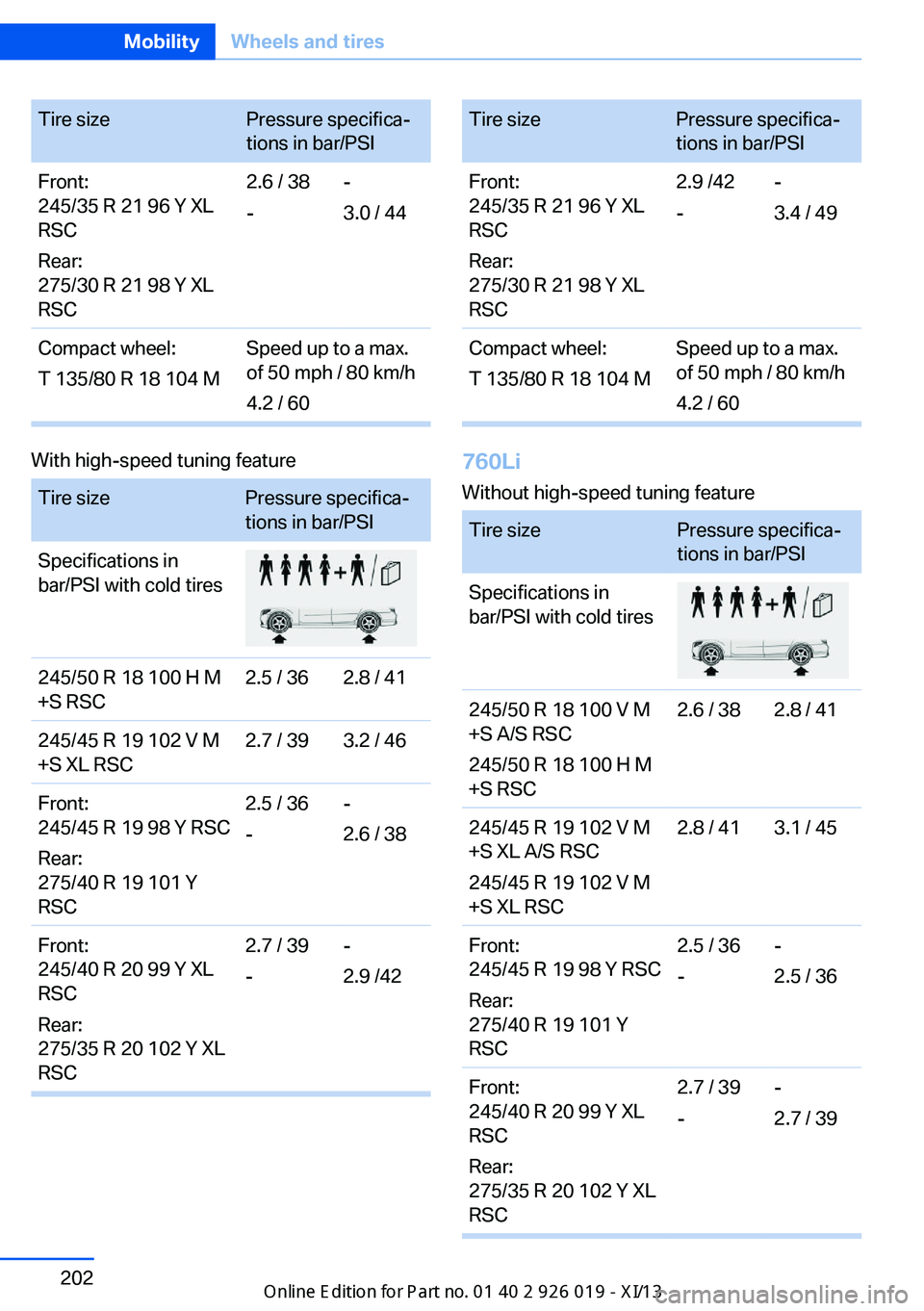
Tire sizePressure specifica‐
tions in bar/PSIFront:
245/35 R 21 96 Y XL
RSC
Rear:
275/30 R 21 98 Y XL
RSC2.6 / 38
--
3.0 / 44Compact wheel:
T 135/80 R 18 104 MSpeed up to a max.
of 50 mph / 80 km/h
4.2 / 60
With high-speed tuning feature
Tire sizePressure specifica‐
tions in bar/PSISpecifications in
bar/PSI with cold tires245/50 R 18 100 H M
+S RSC2.5 / 362.8 / 41245/45 R 19 102 V M
+S XL RSC2.7 / 393.2 / 46Front:
245/45 R 19 98 Y RSC
Rear:
275/40 R 19 101 Y
RSC2.5 / 36
--
2.6 / 38Front:
245/40 R 20 99 Y XL
RSC
Rear:
275/35 R 20 102 Y XL
RSC2.7 / 39
--
2.9 /42Tire sizePressure specifica‐
tions in bar/PSIFront:
245/35 R 21 96 Y XL
RSC
Rear:
275/30 R 21 98 Y XL
RSC2.9 /42
--
3.4 / 49Compact wheel:
T 135/80 R 18 104 MSpeed up to a max.
of 50 mph / 80 km/h
4.2 / 60
760Li Without high-speed tuning feature
Tire sizePressure specifica‐
tions in bar/PSISpecifications in
bar/PSI with cold tires245/50 R 18 100 V M
+S A/S RSC
245/50 R 18 100 H M
+S RSC2.6 / 382.8 / 41245/45 R 19 102 V M
+S XL A/S RSC
245/45 R 19 102 V M
+S XL RSC2.8 / 413.1 / 45Front:
245/45 R 19 98 Y RSC
Rear:
275/40 R 19 101 Y
RSC2.5 / 36
--
2.5 / 36Front:
245/40 R 20 99 Y XL
RSC
Rear:
275/35 R 20 102 Y XL
RSC2.7 / 39
--
2.7 / 39Seite 202MobilityWheels and tires202
Online Edition for Part no. 01 40 2 909 749 - VI/13
Page 207 of 255
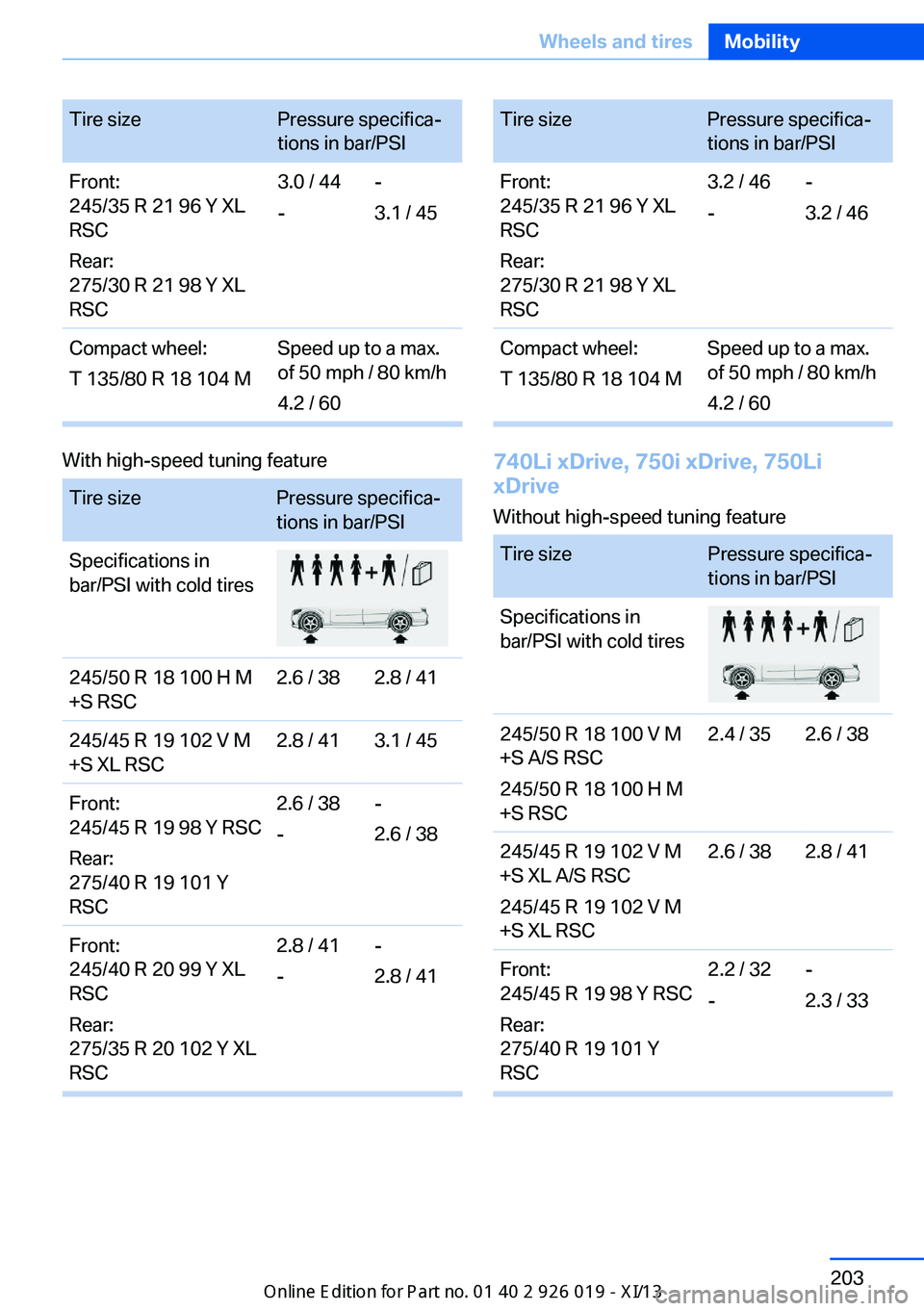
Tire sizePressure specifica‐
tions in bar/PSIFront:
245/35 R 21 96 Y XL
RSC
Rear:
275/30 R 21 98 Y XL
RSC3.0 / 44
--
3.1 / 45Compact wheel:
T 135/80 R 18 104 MSpeed up to a max.
of 50 mph / 80 km/h
4.2 / 60
With high-speed tuning feature
Tire sizePressure specifica‐
tions in bar/PSISpecifications in
bar/PSI with cold tires245/50 R 18 100 H M
+S RSC2.6 / 382.8 / 41245/45 R 19 102 V M
+S XL RSC2.8 / 413.1 / 45Front:
245/45 R 19 98 Y RSC
Rear:
275/40 R 19 101 Y
RSC2.6 / 38
--
2.6 / 38Front:
245/40 R 20 99 Y XL
RSC
Rear:
275/35 R 20 102 Y XL
RSC2.8 / 41
--
2.8 / 41Tire sizePressure specifica‐
tions in bar/PSIFront:
245/35 R 21 96 Y XL
RSC
Rear:
275/30 R 21 98 Y XL
RSC3.2 / 46
--
3.2 / 46Compact wheel:
T 135/80 R 18 104 MSpeed up to a max.
of 50 mph / 80 km/h
4.2 / 60
740Li xDrive, 750i xDrive, 750Li
xDrive
Without high-speed tuning feature
Tire sizePressure specifica‐
tions in bar/PSISpecifications in
bar/PSI with cold tires245/50 R 18 100 V M
+S A/S RSC
245/50 R 18 100 H M
+S RSC2.4 / 352.6 / 38245/45 R 19 102 V M
+S XL A/S RSC
245/45 R 19 102 V M
+S XL RSC2.6 / 382.8 / 41Front:
245/45 R 19 98 Y RSC
Rear:
275/40 R 19 101 Y
RSC2.2 / 32
--
2.3 / 33Seite 203Wheels and tiresMobility203
Online Edition for Part no. 01 40 2 909 749 - VI/13
Page 208 of 255
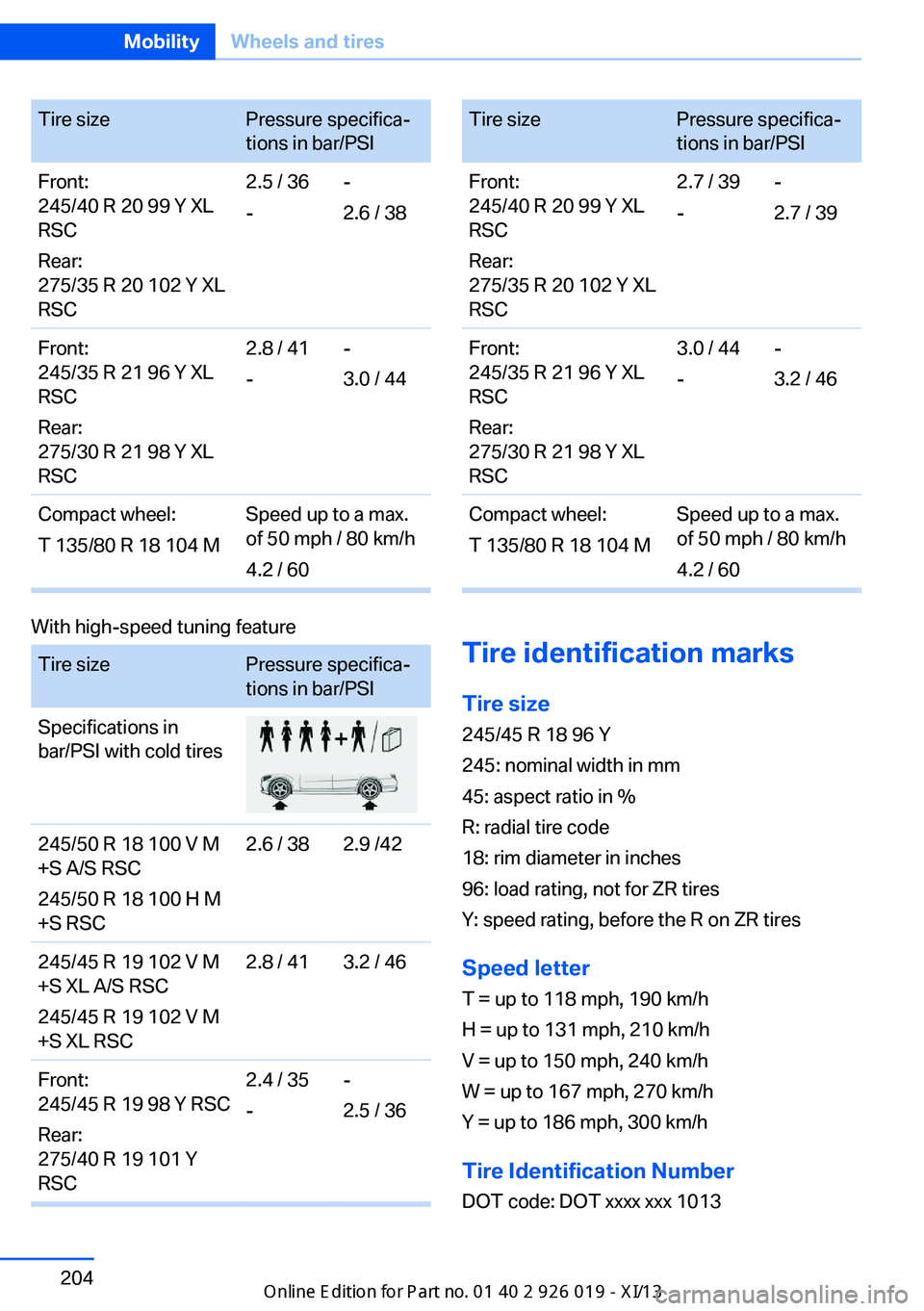
Tire sizePressure specifica‐
tions in bar/PSIFront:
245/40 R 20 99 Y XL
RSC
Rear:
275/35 R 20 102 Y XL
RSC2.5 / 36
--
2.6 / 38Front:
245/35 R 21 96 Y XL
RSC
Rear:
275/30 R 21 98 Y XL
RSC2.8 / 41
--
3.0 / 44Compact wheel:
T 135/80 R 18 104 MSpeed up to a max.
of 50 mph / 80 km/h
4.2 / 60
With high-speed tuning feature
Tire sizePressure specifica‐
tions in bar/PSISpecifications in
bar/PSI with cold tires245/50 R 18 100 V M
+S A/S RSC
245/50 R 18 100 H M
+S RSC2.6 / 382.9 /42245/45 R 19 102 V M
+S XL A/S RSC
245/45 R 19 102 V M
+S XL RSC2.8 / 413.2 / 46Front:
245/45 R 19 98 Y RSC
Rear:
275/40 R 19 101 Y
RSC2.4 / 35
--
2.5 / 36Tire sizePressure specifica‐
tions in bar/PSIFront:
245/40 R 20 99 Y XL
RSC
Rear:
275/35 R 20 102 Y XL
RSC2.7 / 39
--
2.7 / 39Front:
245/35 R 21 96 Y XL
RSC
Rear:
275/30 R 21 98 Y XL
RSC3.0 / 44
--
3.2 / 46Compact wheel:
T 135/80 R 18 104 MSpeed up to a max.
of 50 mph / 80 km/h
4.2 / 60
Tire identification marks
Tire size 245/45 R 18 96 Y
245: nominal width in mm
45: aspect ratio in %
R: radial tire code
18: rim diameter in inches
96: load rating, not for ZR tires
Y: speed rating, before the R on ZR tires
Speed letter
T = up to 118 mph, 190 km/h
H = up to 131 mph, 210 km/h
V = up to 150 mph, 240 km/h
W = up to 167 mph, 270 km/h
Y = up to 186 mph, 300 km/h
Tire Identification Number
DOT code: DOT xxxx xxx 1013
Seite 204MobilityWheels and tires204
Online Edition for Part no. 01 40 2 909 749 - VI/13
Page 209 of 255
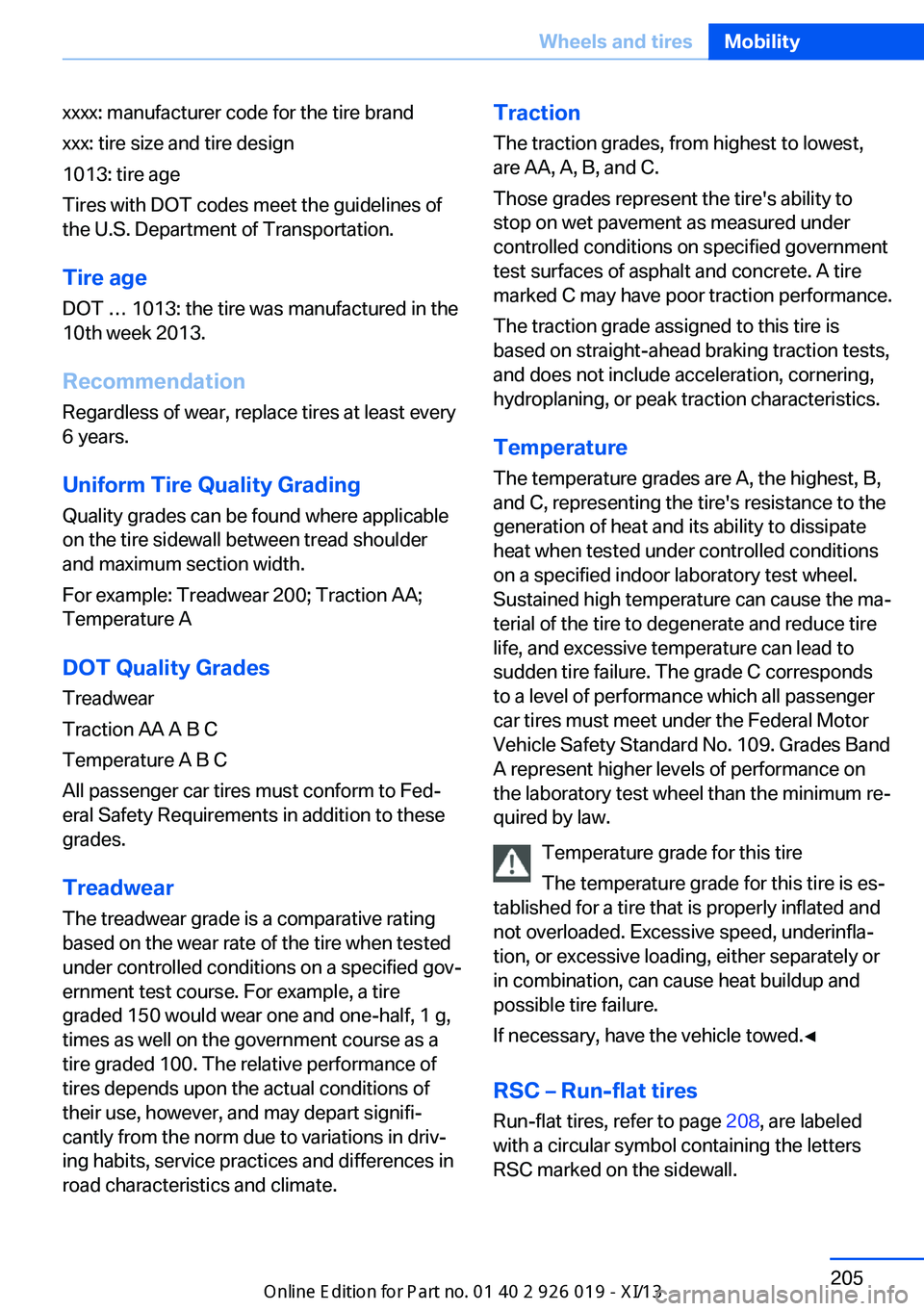
xxxx: manufacturer code for the tire brand
xxx: tire size and tire design
1013: tire age
Tires with DOT codes meet the guidelines of
the U.S. Department of Transportation.
Tire age DOT … 1013: the tire was manufactured in the
10th week 2013.
Recommendation
Regardless of wear, replace tires at least every
6 years.
Uniform Tire Quality Grading
Quality grades can be found where applicable
on the tire sidewall between tread shoulder
and maximum section width.
For example: Treadwear 200; Traction AA;
Temperature A
DOT Quality Grades Treadwear
Traction AA A B C
Temperature A B C
All passenger car tires must conform to Fed‐
eral Safety Requirements in addition to these
grades.
Treadwear The treadwear grade is a comparative rating
based on the wear rate of the tire when tested
under controlled conditions on a specified gov‐
ernment test course. For example, a tire graded 150 would wear one and one-half, 1 g,times as well on the government course as a
tire graded 100. The relative performance of
tires depends upon the actual conditions of
their use, however, and may depart signifi‐
cantly from the norm due to variations in driv‐
ing habits, service practices and differences in
road characteristics and climate.Traction
The traction grades, from highest to lowest,
are AA, A, B, and C.
Those grades represent the tire's ability to
stop on wet pavement as measured under
controlled conditions on specified government
test surfaces of asphalt and concrete. A tire
marked C may have poor traction performance.
The traction grade assigned to this tire is
based on straight-ahead braking traction tests,
and does not include acceleration, cornering,
hydroplaning, or peak traction characteristics.
Temperature
The temperature grades are A, the highest, B,
and C, representing the tire's resistance to the
generation of heat and its ability to dissipate
heat when tested under controlled conditions
on a specified indoor laboratory test wheel.
Sustained high temperature can cause the ma‐
terial of the tire to degenerate and reduce tire
life, and excessive temperature can lead to
sudden tire failure. The grade C corresponds
to a level of performance which all passenger
car tires must meet under the Federal Motor
Vehicle Safety Standard No. 109. Grades Band
A represent higher levels of performance on
the laboratory test wheel than the minimum re‐
quired by law.
Temperature grade for this tire
The temperature grade for this tire is es‐
tablished for a tire that is properly inflated and
not overloaded. Excessive speed, underinfla‐
tion, or excessive loading, either separately or
in combination, can cause heat buildup and
possible tire failure.
If necessary, have the vehicle towed.◀
RSC – Run-flat tires
Run-flat tires, refer to page 208, are labeled
with a circular symbol containing the letters
RSC marked on the sidewall.Seite 205Wheels and tiresMobility205
Online Edition for Part no. 01 40 2 909 749 - VI/13
Page 210 of 255
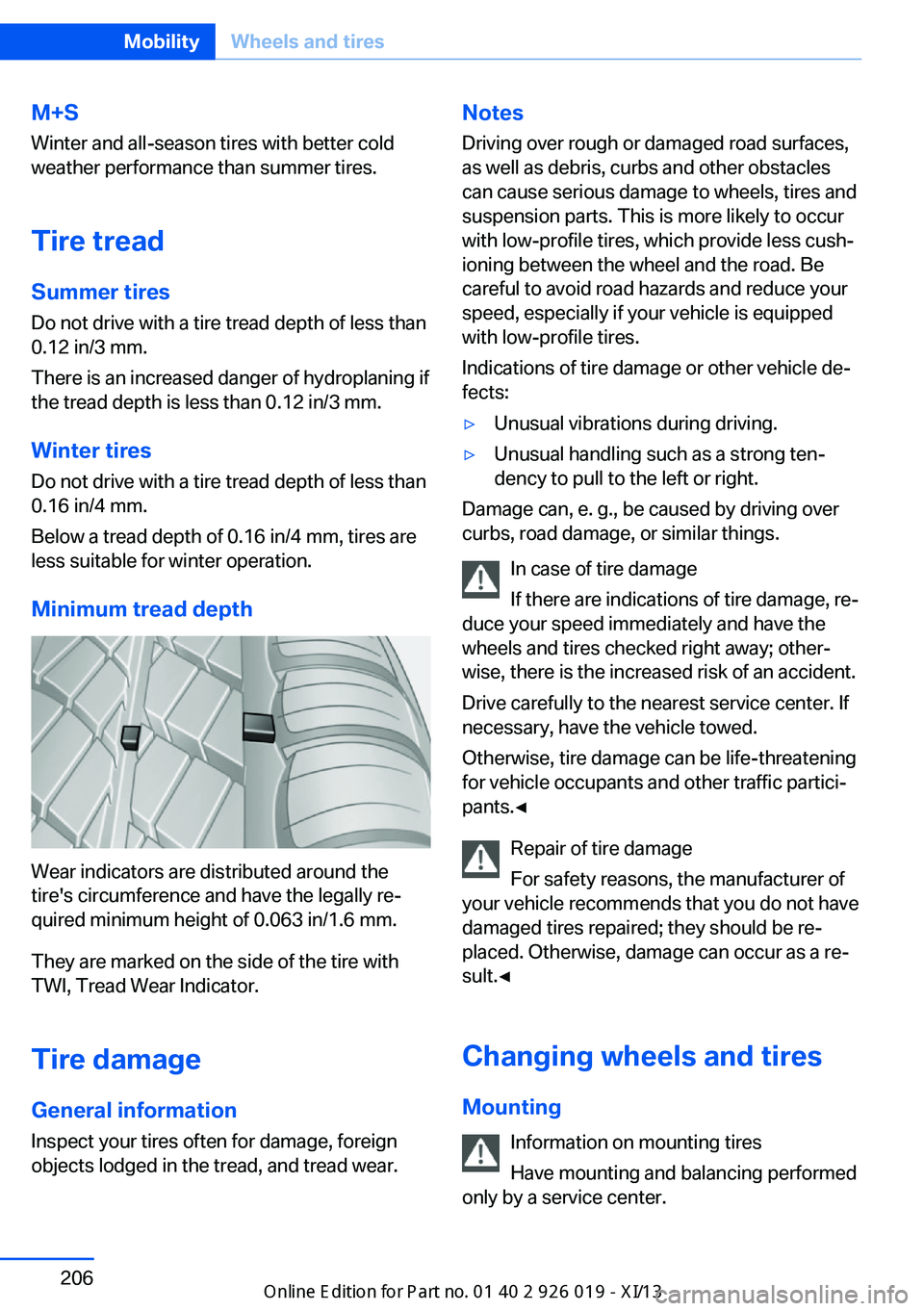
M+S
Winter and all-season tires with better cold
weather performance than summer tires.
Tire tread Summer tires
Do not drive with a tire tread depth of less than
0.12 in/3 mm.
There is an increased danger of hydroplaning if
the tread depth is less than 0.12 in/3 mm.
Winter tires
Do not drive with a tire tread depth of less than
0.16 in/4 mm.
Below a tread depth of 0.16 in/4 mm, tires are
less suitable for winter operation.
Minimum tread depth
Wear indicators are distributed around the
tire's circumference and have the legally re‐
quired minimum height of 0.063 in/1.6 mm.
They are marked on the side of the tire with
TWI, Tread Wear Indicator.
Tire damage
General information
Inspect your tires often for damage, foreign
objects lodged in the tread, and tread wear.
Notes
Driving over rough or damaged road surfaces,
as well as debris, curbs and other obstacles
can cause serious damage to wheels, tires and
suspension parts. This is more likely to occur
with low-profile tires, which provide less cush‐
ioning between the wheel and the road. Be
careful to avoid road hazards and reduce your
speed, especially if your vehicle is equipped
with low-profile tires.
Indications of tire damage or other vehicle de‐
fects:▷Unusual vibrations during driving.▷Unusual handling such as a strong ten‐
dency to pull to the left or right.
Damage can, e. g., be caused by driving over
curbs, road damage, or similar things.
In case of tire damage
If there are indications of tire damage, re‐
duce your speed immediately and have the
wheels and tires checked right away; other‐
wise, there is the increased risk of an accident.
Drive carefully to the nearest service center. If
necessary, have the vehicle towed.
Otherwise, tire damage can be life-threatening
for vehicle occupants and other traffic partici‐
pants.◀
Repair of tire damage
For safety reasons, the manufacturer of
your vehicle recommends that you do not have
damaged tires repaired; they should be re‐
placed. Otherwise, damage can occur as a re‐
sult.◀
Changing wheels and tires
Mounting Information on mounting tires
Have mounting and balancing performed
only by a service center.
Seite 206MobilityWheels and tires206
Online Edition for Part no. 01 40 2 909 749 - VI/13